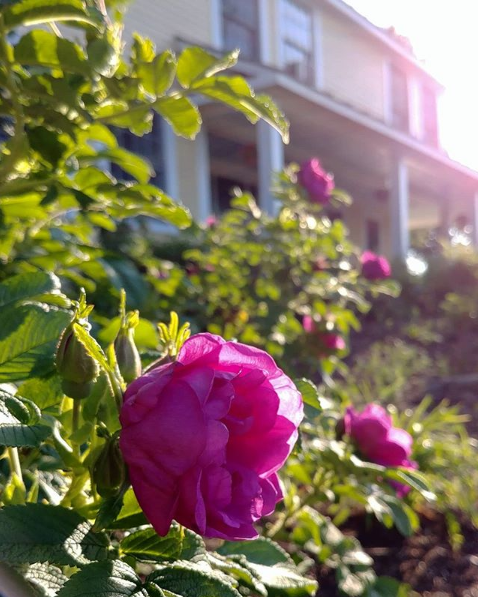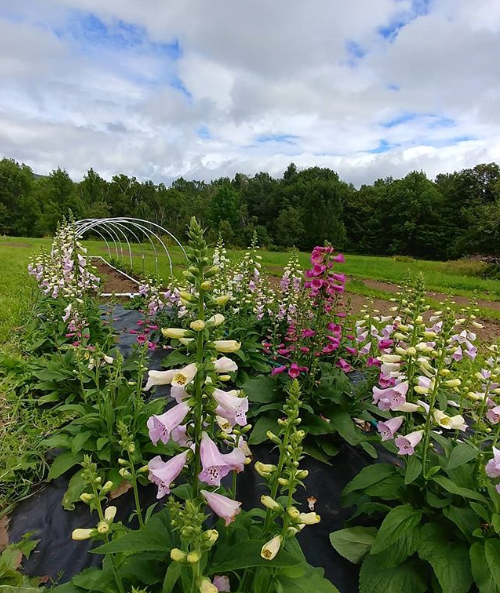It’s been a while since we have updated the blog, mostly because the summer is such a full, verdant, vibrant time to be here. It’s been a hot summer and we have spent a lot of time outdoors appreciating the beauty and working on projects outside to improve our guests’ experience.
So much has happened since our last post! In a quick recap of summer, everything is in bloom and we are extending the boundaries of our gardens to make room for new flowers and crops. Luke has put in 8 new flowers beds in the lower field, and his plans include spring, summer and fall blooming flowers. It really has been a joy to see them bursting out in a colorful array. We are excited to experience each new season and the surprise of flowers that pop up in the freshly tilled soil.
Luke has added new flower beds in the lower field, where every season we enjoy new blooms!
Now, with more flowers to tend to, Luke is working on perfecting our irrigation system. With a series of timers and gravity fed spigots that draw water from the pond, we are getting closer to nurturing the plants to their optimum potential. (More on this, later!)
Dahlias are some of our favorite summer blooms!
I’m coming to realize that we just don’t have enough vases for all of the flowers that are adorning the property. It has been such a rejuvenating experience each week to fill a bucket until it is brimming over with flowers to make bouquets for every room. In true form, the square footage (or acreage) of Luke’s gardens grow by 20-30% every year. What started as a 10x10’ plot has grown to 5,000 square feet. I think next year we will have to start a little flower stand or bring them to market, as they are so beautiful and abundant!
Foxgloves bloom in the lower field, where Luke has planted a cutting garden.
Our chickens have learned how to escape their coop and we love seeing them explore free-range, enjoying the fresh food available in the garden and yard. They have gotten braver and friendlier with each day, where now you must close the doors and windows of your car or they might take it up as their new roost. I absolutely love them. As I write this, they are hunting and pecking around my feet at the pebbles of our outdoor patio. Now that they are exploring a wider footprint of the property, we sometimes find their eggs on the lawn, which brings back all of the joys of childhood scavenger hunts and Easter egg parties!
Our friendly little chickens enjoy exploring the property at our Vermont Bed and Breakfast, free-range!
The Bed and Breakfast has been busy and we have loved seeing returning guests, who we are happy have enjoyed their experience enough to come back – some have even brought friends on their return journey! We have had a few long-term stay guests and it has been fun to get to know people better and see them feel at-home as guests at our Vermont Bed and Breakfast.
Guests at our B&B enjoy a cup of tea or coffee and the view from our Vermont Bed and Breakfast.
One project that truly excited me to accomplish was the addition of a tiny free library, which guests can enjoy as they walk the path around the pond. Placed just next to a mossy rock, it’s the perfect place to read a little poem or reference a bird watching book to see what species just flew by. As I write this, a hummingbird stopped by to visit the zinnias and enjoy their sweet nectar. I find that if you are quiet for a moment here, you are bound to see something awe-inspiring.
Check out the books in our new tiny free library!
It has been a fun and delicious experience to enjoy the berries and fruit that grow on the property. We had a very healthy crop of currants this year and the walk around the pond easily becomes a feast when the raspberries are in full season, as they were earlier this month. The blueberries are still a little young to harvest but are starting to show the signs of fruit development and hold promise for next year. Our next big crop will be apples, which are starting to blush a beautiful pink. Our dog, Stout, is starting to visit the apple trees to snack on the sweet and tart treats.
Summer is winding down and we are savoring every day that we get to play outside and enjoy this beautiful place. Fall foliage is starting to turn and we are looking forward to the crisp air and coziness that autumn brings to New England. We are so grateful to live here and share this experience with guests at our Bed and Breakfast.
-Carin McCarthy














